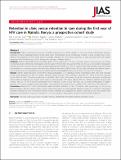Retention in Clinic versus Retention in Care During the First Year of HIV Care in Nairobi, Kenya: a prospective cohort study
View/
Publication Date
2018-11-01Type
Article, Journalviews
downloads
Metadata
Show full item recordCitation
van der Kop, M.L., Nagide, P.I., Thabane, L., Gelmon, L.J., Kyomuhangi, L.B., Abunah, B., Ekström, A.M., & Lester, R.T. (2018). Retention in clinic versus retention in care during the first year of HIV care in Nairobi, Kenya: a prospective cohort study. Journal of the International AIDS Society, 21.
Abstract/
Introduction: When measuring the success of HIV programmes to retain patients in care, few studies distinguish between retention in clinic (individual returns to the same clinic) and retention in care (individual is active in care at initial site or else where). The objectives of this study were to quantify retention in clinic versus retention in care and determine risk factors associated with attrition from care in low-income settings in Nairobi, Kenya. Methods: Between April 2013 and June 2015, adults testing positive for HIV were recruited at two comprehensive care clinics in informal urban settlements. Participants were followed from the time of a positive HIV test for up to 14 months. Participants who did not return to the clinic for their 12-month appointment between 10 and 14 months after their baseline visit were traced by telephone or community outreach to determine whether they were still receiving HIV care. We used generalized linear regres sion to determine the association between clinical and socio-demographic factors and attrition from care at 12 months. Results: Of the 1068 individuals screened for study participation, 775 individuals newly presenting to HIV care were included in this study. Between 10 and 14 months, 486 participants (62.7%, 95% confidence intervals [CI], 59.2% to 66.1%) returned to the clinic for their 12-month appointment (retained in clinic). After telephone tracing and community outreach, an additional 123 of 289 participants were found to be active in care at other HIV clinics (42.6%, 95% CI, 36.8% to 48.5%). Overall, 609 (78.6%, 95% CI, 75.7% to 81.5%) participants were retained in care at any HIV clinic at 12 months. Participants in higher baseline CD4 count categories were more likely to be retained than those whose baseline CD4 count was <200 cells/mm3. Conclusions: Retention in clinic substantially underestimated retention in care 12 months after presenting to care in this high-prevalence and low-income urban setting. Improved systems to track patients between clinics are required to accurately estimate retention in care in resource-limited settings. Although the proportion of patients retained in care was greater than expected, interventions to improve retention in care are needed to meet global targets to end the AIDS epidemic.
Subject/
HIV care continuum; Cohort studies; Informal settlements; HIV/AIDS; Patient retention; Kenya
Further Details
Copyright © 2018 The Authors. Journal of the International AIDS Society published by John Wiley & Sons Ltd on behalf of the International AIDS Society. This is an open access article under the terms of the Creative Commons Attribution License, which permits use, distribution and reproduction in any medium, provided the original work is properly cited.
Publisher
JIASCollections
- General - GEN [367]

